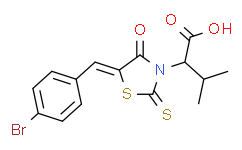| Cas No.: | 300817-68-9 |
| Chemical Name: | BH3I-1 |
| Synonyms: | 3-Thiazolidineaceticacid, 5-[(4-bromophenyl)methylene]-a-(1-methylethyl)-4-oxo-2-thioxo-;BH3I-1;BH 3I1;BHI1;BHI-1;5-(p-Bromobenzylidine)-α-isopropyl-4-oxo-2-thioxo-3-thiozolidineacetic acid;BH3I 1;2-[5-[(4-bromophenyl)methylidene]-4-oxo-2-sulfanylidene-3-thiazolidinyl]-3-methylbutanoic acid;CBDivE_015522;BCP17483;AK547723;Q27163497;2-[(5E)-5-[(4-bromophenyl)methylidene]-4-oxo-2-sulfanylidene-1,3-thiazolidin-3-yl]-3-methylbutanoic acid |
| SMILES: | BrC1C([H])=C([H])C(=C([H])C=1[H])C([H])=C1C(N(C(=S)S1)C([H])(C(=O)O[H])C([H])(C([H])([H])[H])C([H])([H])[H])=O |
| Formula: | C15H14BrNO3S2 |
| M.Wt: | 400.3106 |
| Purity: | >98% |
| Sotrage: | 2 years -20°C Powder, 2 weeks 4°C in DMSO, 6 months -80°C in DMSO |
| Description: | BH3I-1 is a Bcl-2 family antagonist, which inhibits the binding of the Bak BH3 peptide to Bcl-xL with a Ki of 2.4±0.2 μM in FP assay. BH3I-1 has a Kd of 5.3 μM against the p53/MDM2 pair. |
| In Vitro: | BH3I-1, while inhibiting its reported target Bcl-2/Bim and Bcl-xL/Bim, shows significant inhibition of both the p53/hDM2 and p300/Hif-1α interactions. This surprising promiscuity, displays by a well studied compound leads to further interrogate the p53/hDM2 interaction utilizing a standard fluorescence polarization (FP) assay with purified protein. The results from the FP assay validates the split-luciferase screen and demonstrates that BH3I-1 has a Kd=5.3 μM against the p53/mDM2 pair, which is comparable to its low micromolar potency reported for the BH3 family of receptors[2]. BH3I-1 inhibits interaction between the BH3 domain and Bcl-xL. NMR analyses reveal that BH3I-1 targets the BH3-binding pocket of Bcl-xL with a Ki of 7.8±0.9 μM[3]. |
| Cell Assay: | Jurkat cells overexpressing Bcl-xL, FL 5.12 and FL 5.12/Bcl-xL cells (5×104 cells per well) are seeded into white 96-well plates and treated with various concentrations of the compounds (e.g., BH3I-1; 30 μM and 90 μM)for 48 h. For zVAD-FMK protection experiments, cells are preincubated with 100 μM zVAD-FMK for 1 h before the addition of chemicals. Cell viability is determined with an MTS assay with a Victor plate reader. For PI staining experiments, cells are grown in 24-well plates and then incubated with 2 μg/mL PI. Cell death is determined by FACS analysis in a FACSCalibur machine[3]. |
| References: | [1]. Wang L, et al. Development of dimeric modulators for anti-apoptotic Bcl-2 proteins. Bioorg Med Chem Lett. 2008 Jan 1;18(1):236-40. [2]. Porter JR, et al. Profiling small molecule inhibitors against helix-receptor interactions: the Bcl-2 family inhibitor BH3I-1 potently inhibits p53/hDM2. Chem Commun (Camb). 2010 Nov 14;46(42):8020-2. [3]. Degterev A, et al. Identification of small-molecule inhibitors of interaction between the BH3 domain and Bcl-xL. Nat Cell Biol. 2001 Feb;3(2):173-82. |






















